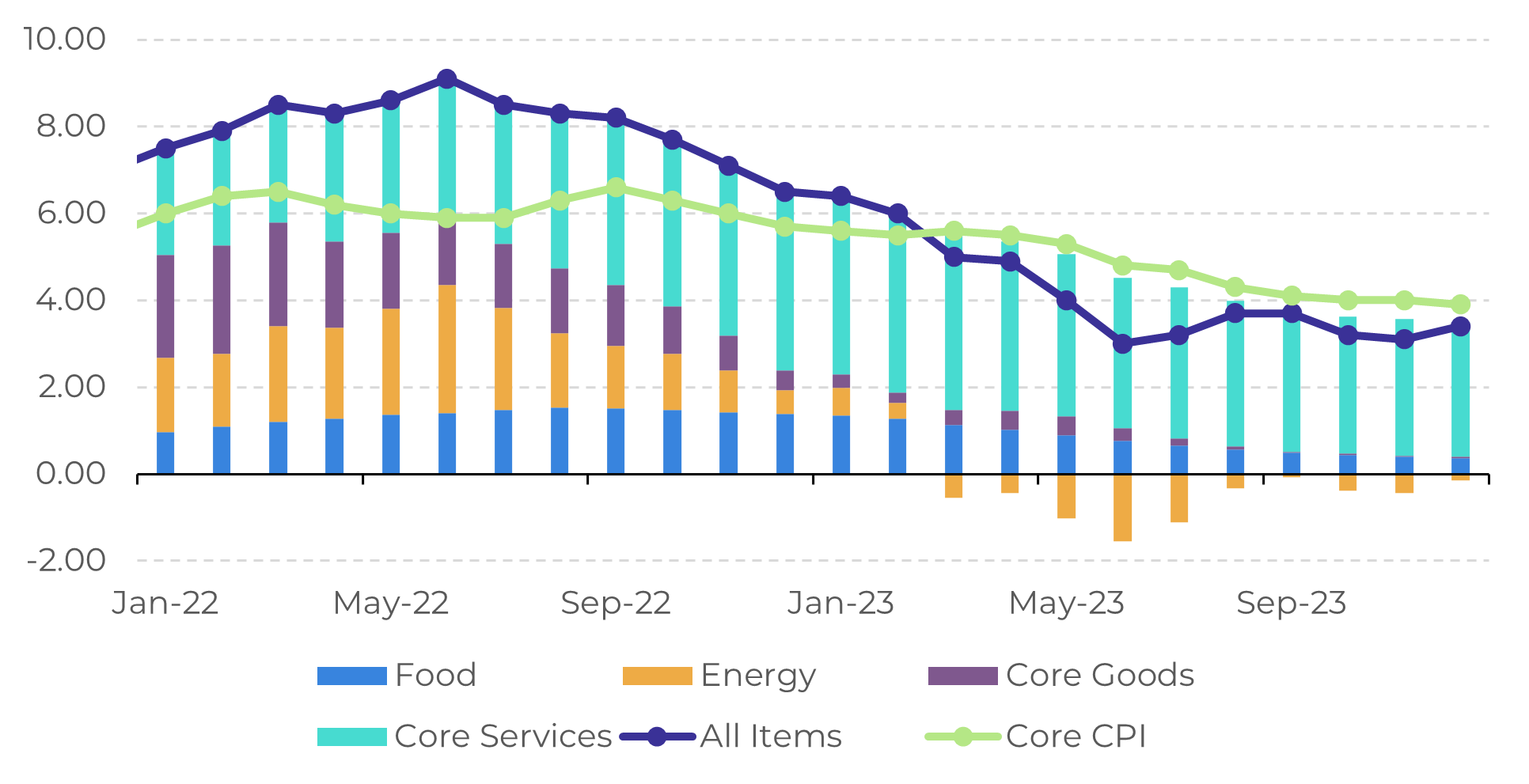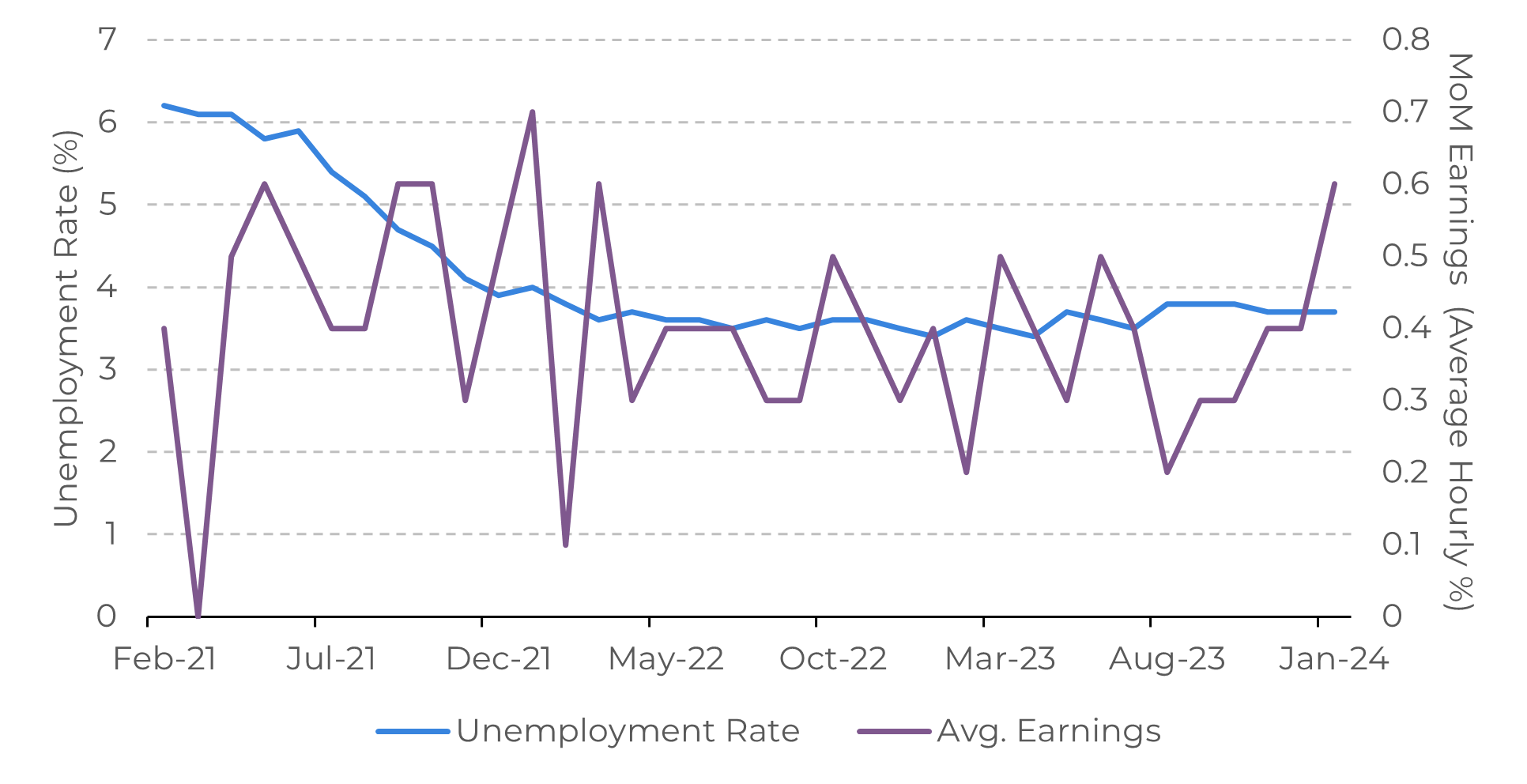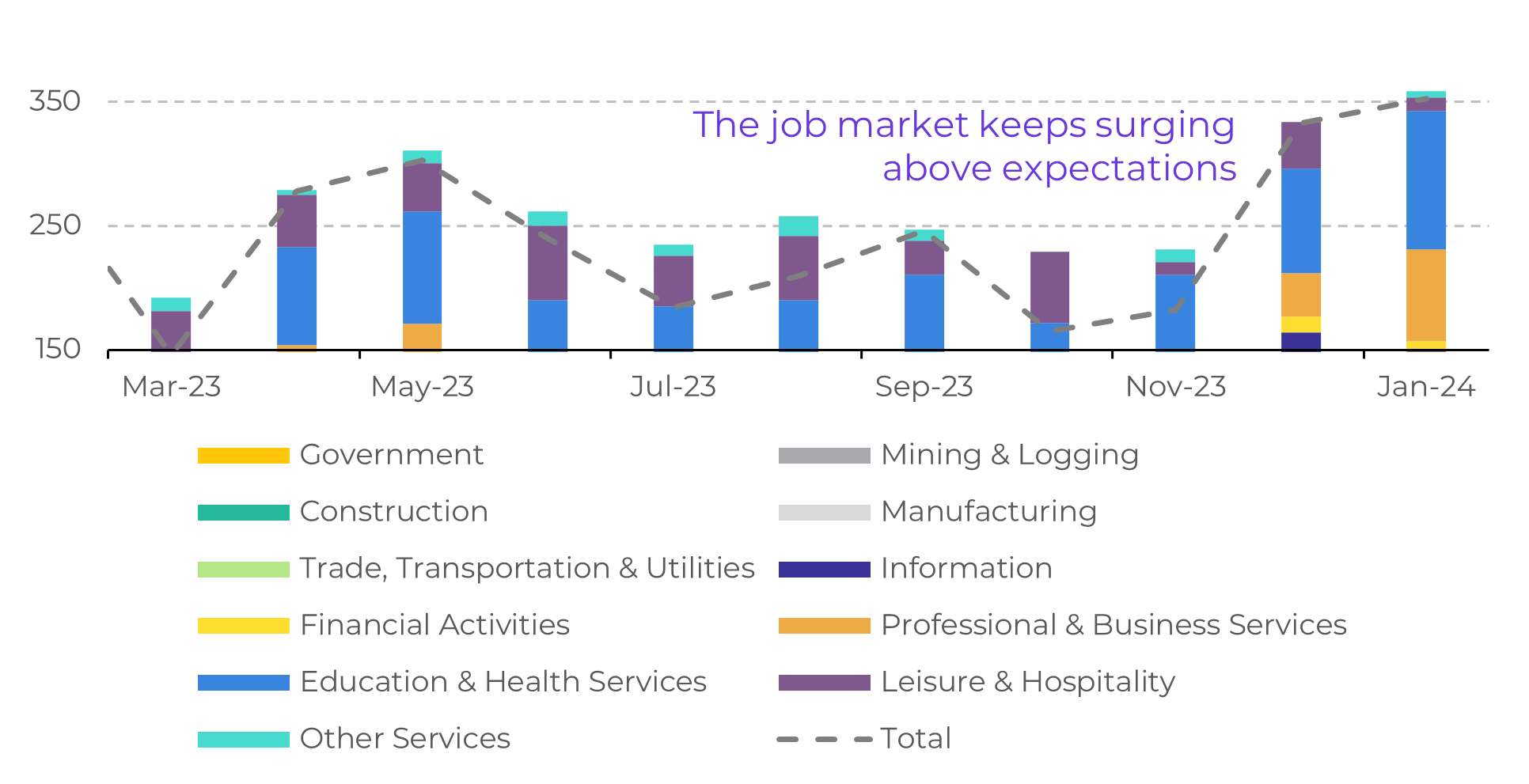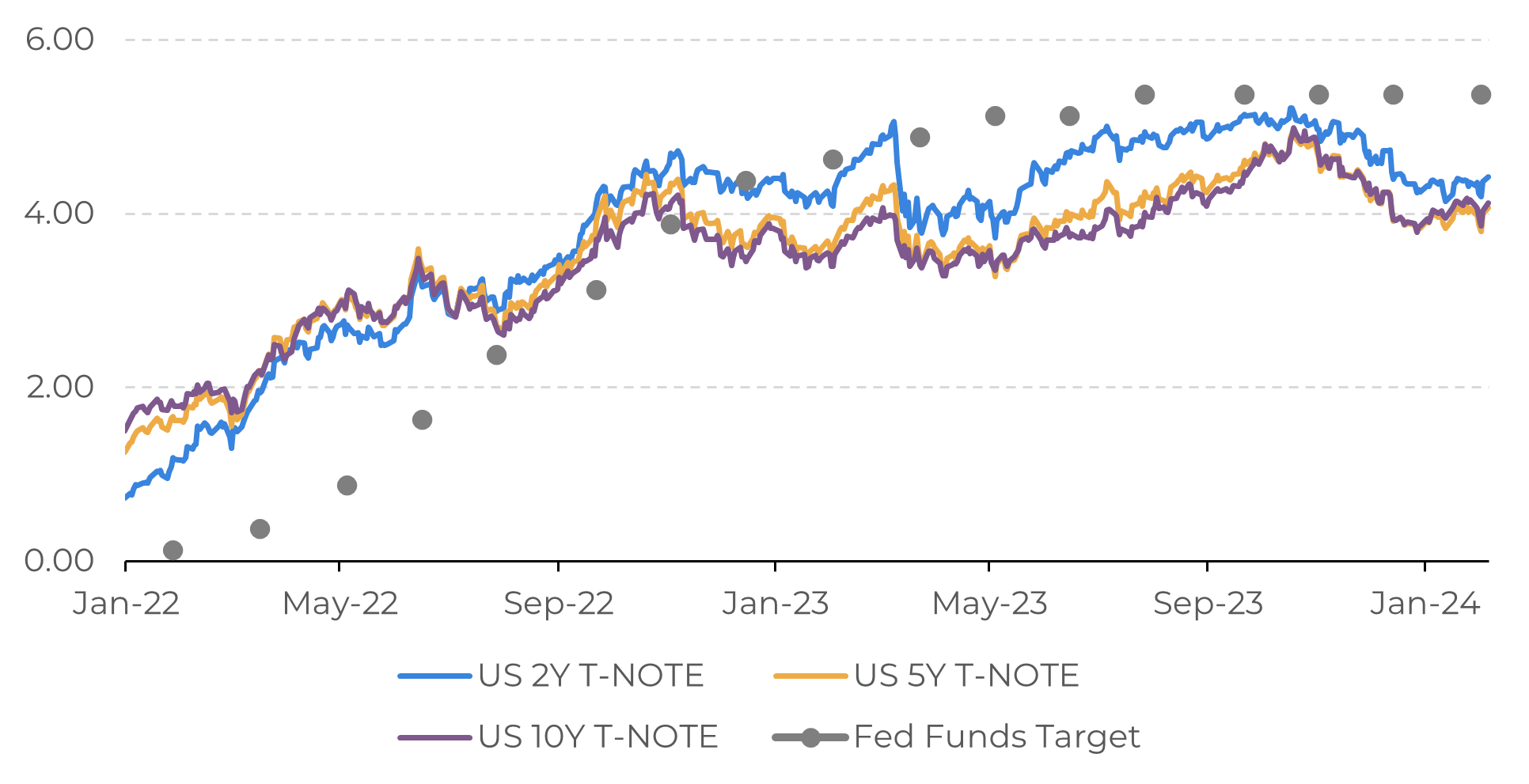
Feb 6
/
Victor Arduin
Macroeconomics Weekly Report - 2024 02 06
Back to main blog page
When will the Fed cut interest rates?
- Last week, the first 2024 Fed meeting took place, a widely anticipated event in the market seeking clues as to when there will be an interest rate cut in the world's largest economy.
- For now, nothing changes. The FOMC decided to keep the interest rate unchanged, and there was no official communication, the forward guidance, that monetary policy easing could occur in March.
- The challenge, therefore, is to understand what is missing for the American central bank to have the necessary confidence to start cutting the interest rate. Let’s check in details some indicatiors to understand it.
Introduction
Despite the great market expectations surrounding the Fed's first meeting in 2024, there is still no clear communication regarding the onset of monetary easing. And if we rely on economic data, as is constantly emphasized in the speeches of the organization's chairman, Jerome Powell, there is no reason for such an early start.
In this regard, what signals need to be observed by FOMC members for the beginning of an interest rate easing in the world's largest economy? This will be the central point of analysis in this report, but an important development in the US Treasury bond market will also be highlighted.
Image 1: US – CPI Inflation (%)

Source: U.S. Bureau of Labor Statistics
Image 2:
US – Unemployment Rate and Nonfarm Payrolls
Earnings (%)

Source: Refinitiv, Bureau of Labor Statistics
The labor market situation doesn't warrant a rush to cut interest rates
The resilient labor market remains one of the biggest concerns for the country's monetary authorities. An example of this is that in the first month of the year, 353,000 jobs were added, surpassing expectations. With robust economic activity and wage gains above inflation, there are no incentives for such a rapid interest rate cut in the economy, and the Fed will need to observe a cooling off of these numbers.
Despite the importance of the economy, there are more reasons for a more cautious approach to interest rate cuts. Inflation remains above the target, and while the decline in energy costs in 2023 helped reduce prices significantly, the pace of improvement in the inflationary outlook for 2024 may not be as fast. It is safer to leave the effects of restrictive monetary policy on the economy for a little longer
Despite the importance of the economy, there are more reasons for a more cautious approach to interest rate cuts. Inflation remains above the target, and while the decline in energy costs in 2023 helped reduce prices significantly, the pace of improvement in the inflationary outlook for 2024 may not be as fast. It is safer to leave the effects of restrictive monetary policy on the economy for a little longer
Image 3: US – Total Nonfarm Payrolls (Thousand)

Source: Bloomberg
However, the market has already begun to price in a scenario of interest rate cuts for this year, something that can be observed through the yields of 2, 5, and 10-year bonds (T-notes). If a reduction in yields is the natural path due to monetary policy easing, this trajectory will be accompanied by a lot of volatility and supportive fundamentals.
The government finances its activities essentially through two mechanisms: tax collection and debt issuance. As the United States is recording larger deficits, the pressure for the issuance of more Treasury bonds is increasing. The fiscal imbalance brings a premium to the bonds, a fundamental that will be present this year, despite the fall in interest rates.
The government finances its activities essentially through two mechanisms: tax collection and debt issuance. As the United States is recording larger deficits, the pressure for the issuance of more Treasury bonds is increasing. The fiscal imbalance brings a premium to the bonds, a fundamental that will be present this year, despite the fall in interest rates.
Image 4: US – Treasury Yields and Fed Funds Target(%)

Source: Refinitiv
In Summary
It's highly unlikely that there won't be an interest rate cut in 2024. The inflationary environment, although still posing risks, has improved significantly in recent months, and the market is already pricing in a less restrictive monetary scenario on the horizon.
In the coming months, there should be an improvement in inflation, but with possible negative surprises from price components that may be under pressure, such as services and goods. However, this will bring more volatility than a change in the basis scenario, that is, the cut in interest rates for this year.
However, there will be a significant impact when the monetary policy easing occurs, and there are risks in lowering rates too early. A resilient labor market and strong economic activity are examples that it's not yet time for a rate cut.
In the coming months, there should be an improvement in inflation, but with possible negative surprises from price components that may be under pressure, such as services and goods. However, this will bring more volatility than a change in the basis scenario, that is, the cut in interest rates for this year.
Weekly Report — Macro
Written by Victor Arduin
victor.arduin@hedgepointglobal.com
victor.arduin@hedgepointglobal.com
Reviewed by Alef Dias
alef.dias@hedgepointglobal.com
alef.dias@hedgepointglobal.com
www.hedgepointglobal.com
Disclaimer
This document has been prepared by hEDGEpoint Global Markets LLC and its affiliates ("HPGM") exclusively for informational and instructional purposes, without the purpose of creating obligations or commitments with third parties, and is not intended to promote an offer, or solicitation of an offer, to sell or buy any securities or investment products. HPGM and its associates expressly disclaim any use of the information contained herein that may result in direct or indirect damage of any kind. If you have any questions that are not resolved in the first instance of contact with the client (client.services@hedgepointglobal.com), please contact our internal ombudsman channel (ouvidoria@hedgepointglobal.com) or 0800-878-8408 (for clients in Brazil only).
Contact us
hedgepointhub.support@hedgepointglobal.com
ouvidoria@hedgepointglobal.com
Funchal Street, 418, 18º floor - Vila Olímpia São Paulo, SP, Brasil
Check our general terms and important notices.
This page has been prepared by Hedgepoint Schweiz AG and its affiliates (“Hedgepoint”) solely for informational and instructional purposes, without the purpose of instituting obligations or commitments to third parties, nor is it intended to promote an offer, or solicitation of an offer of sale or purchase relating to any securities, commodities interests or investment products. Hedgepoint and its associates expressly disclaim any use of the information contained herein that directly or indirectly result in damages or damages of any kind. Information is obtained from sources which we believe to be reliable, but we do not warrant or guarantee the timeliness or accuracy of this information. The trading of commodities interests such as futures, options, and swaps involves substantial risk of loss and may not be suitable for all investors. You should carefully consider wither such trading is suitable for you in light of your financial condition. Past performance is not necessarily indicative of future results. Customers should rely on their own independent judgement and/or advisors before entering in any transaction.Hedgepoint does not provide legal, tax or accounting advice and you are responsible for seeking any such advice separately.Hedgepoint Schweiz AG is organized, incorporated, and existing under the laws of Switzerland, is filiated to ARIF, the Association Romande des Intermédiaires Financiers, which is a FINMA-authorized Self-Regulatory Organization. Hedgepoint Commodities LLC is organized, incorporated, and existing under the laws of the USA, and is authorized and regulated by the Commodity Futures Trading Commission (CFTC) and a member of the National Futures Association (NFA) to act as an Introducing Broker and Commodity Trading Advisor. HedgePoint Global Markets Limited is Regulated by the Dubai Financial Services Authority. The content is directed at Professional Clients and not Retail Clients. Hedgepoint Global Markets PTE. Ltd is organized, incorporated, and existing under the laws of Singapore, exempted from obtaining a financial services license as per the Second Schedule of the Securities and Futures (Licensing and Conduct of Business) Act, by the Monetary Authority of Singapore (MAS). Hedgepoint Global Markets DTVM Ltda. is authorized and regulated in Brazil by the Central Bank of Brazil (BCB) and the Brazilian Securities Commission (CVM). Hedgepoint Serviços Ltda. is organized, incorporated, and existing under the laws of Brazil. Hedgepoint Global Markets S.A. is organized, incorporated, and existing under the laws of Uruguay. In case of questions not resolved by the first instance of customer contact (client.services@Hedgepointglobal.com), please contact internal ombudsman channel (ombudsman@hedgepointglobal.com – global or ouvidoria@hedgepointglobal.com – Brazil only) or call 0800-8788408 (Brazil only).Integrity, ethics, and transparency are values that guide our culture. To further strengthen our practices, Hedgepoint has a whistleblower channel for employees and third-parties by e-mail ethicline@hedgepointglobal.com or forms Ethic Line – Hedgepoint Global Markets.Security note: All contacts with customers and partners are conducted exclusively through our domain @hedgepointglobal.com. Do not accept any information, bills, statements or requests from different domains and pay special attention to any variations in letters or spelling, as they may indicate a fraudulent situation.“HedgePoint” and the “HedgePoint” logo are marks for the exclusive use of HedgePoint and/or its affiliates. Use or reproduction is prohibited, unless expressly authorized by HedgePoint. Furthermore, the use of any other marks in this document has been authorized for identification purposes only. It does not, therefore, imply any rights of HedgePoint in these marks or imply endorsement, association or seal by the owners of these marks with HedgePoint or its affiliates.
We have updated our Terms & Conditions to reflect improvements to our platform, data handling practices, and the overall experience we provide to our clients.
To continue using the Hedgepoint HUB, please review and accept the updated terms.

